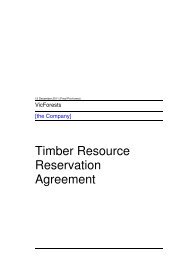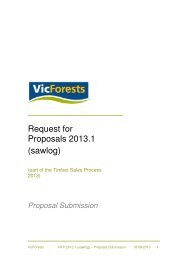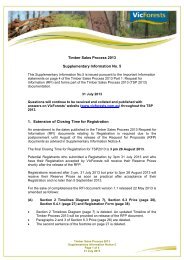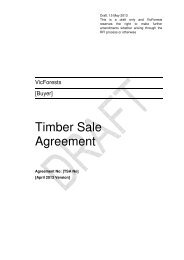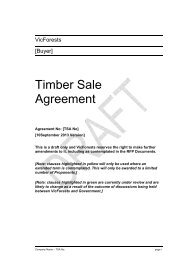Module 5 - VicForests
Module 5 - VicForests
Module 5 - VicForests
Create successful ePaper yourself
Turn your PDF publications into a flip-book with our unique Google optimized e-Paper software.
Conclusions<br />
5<br />
5<br />
5.1 Overall assessment of compliance<br />
The audit included assessment of 27 coupes, including five fire salvage coupes and one thinnings<br />
coupe, selected to be representative of harvesting undertaken in the 2008-09 financial year, with the<br />
exception of domestic firewood coupes.<br />
Overall, the audit identified a high level of compliance across most Compliance Element groups, with<br />
moderate compliance in the Biodiversity Conservation group, mainly due to the absence of monitoring<br />
and control of noxious weeds.<br />
The Auditor noted a number of individual examples of good practice, including instances of:<br />
Conservative delineation of rainforest boundaries for ease of management;<br />
Particularly good examples of snig track rollover drains on a relatively steep slope;<br />
Reuse of existing landings and road alignments and effective use of natural outslope drainage<br />
where possible;<br />
Minimisation of vegetation clearance widths for road construction; and<br />
Minimisation of the area and impact of snig tracks.<br />
No non-compliances with Severe EIA risk rating were identified. Two non-compliances with an EIA<br />
risk rating of Major were identified, both being instances of machine entry into rainforest buffer and<br />
associated rainforest.<br />
The majority (59%) of non-compliances identified were determined as having EIA risk ratings of<br />
Negligible or No impact, with 49 of the total of 150 non-compliances being assessed as Negligible and<br />
40 assessed as No impact. Thirty-one Moderate and 28 Minor non-compliances were also identified,<br />
mainly in the following areas:<br />
One instance of soil stockpiling within a rainforest buffer for road rehabilitation without documented<br />
and approved plans;<br />
Insufficient topsoil and retention of excess bark at landings;<br />
Lack of noxious weed assessments and control;<br />
Inadequate or inappropriate drainage of sections of roads, snig tracks and boundary tracks;<br />
Inadequate management of cut and fill on some sections of roads;<br />
Instances of road construction on steeper slopes than prescribed for the soil type;<br />
Crossing of drainage lines without approval;<br />
Instances of debris pushed or rolled into exclusion zones;<br />
Inadequate evidence that authorisation was given to remove trees felled into buffers; and<br />
Instances of failure to classify streams adjacent to coupes.<br />
This audit report includes four recommendations for improvement where current systems are not<br />
considered adequate to meet the relevant audit criteria. They relate to weed control; fire salvage<br />
machinery cleaning protocols; closure of roads no longer needed; and disposal of excess bark when<br />
not undertaking regeneration burning. All recommendations apply to <strong>VicForests</strong> operations and two<br />
also apply<br />
to DSE.<br />
5.2 Risks to beneficial uses<br />
The audit did not identify any imminent environmental hazards or unacceptable risks to the beneficial<br />
uses listed in Section 2.3 of this report. The assessment of imminent environmental hazards was<br />
based on site observations and EIA risk rating assessments of identified non-compliances, using the<br />
42807504/01/01 55




